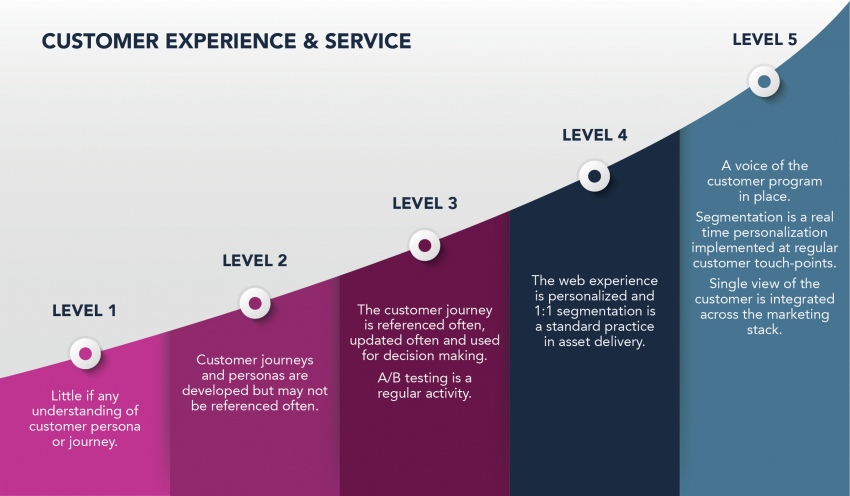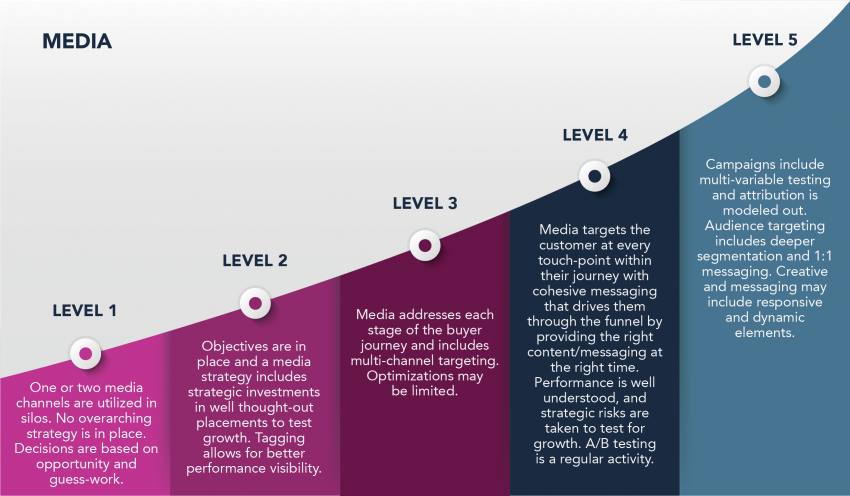Marketing Maturity Models aren’t a new concept, and of course, Zion & Zion didn’t invent them. If you search “Marketing Maturity Model,” you’ll find page after page of different applications of them, all tailored slightly to the expertise of the author. Each of them explores a particular flavor of marketing, whether it be data driven marketing maturity, content marketing, social media, or product management. However, when we embarked on this research, we were searching for something higher level, more operational, a summary – something that said HERE is where you are, and THIS is where you could get to. We wanted to take an existing concept related to marketing maturity and develop a framework that could be applied to the various cross-sections of our clients’ marketing strategies.
A Marketing Maturity Model is a tool that allows a business to evaluate the current state of their marketing sophistication and strategically move upwards in overall maturity. It gets increasingly more difficult to move up each level and the magnitude of outputs are inversely related (meaning, it takes more effort to go from level 3 to 4 than from level 1 to 2, and the subsequent results decrease as maturity increases). This applies also to the level of resources required to successfully move up to and maintain position within a level. We’ve defined five levels starting at 1 – the easiest and least sophisticated to 5 – the most difficult to attain. We further defined a marketing maturity model based on this framework for the following cross-sections of a marketing strategy: brand, data & analytics, media, content & social, marketing automation and customer experience, which we’ll explore further in this article.

Level 1: OPPORTUNITSTIC “adhering to a policy of opportunism; practicing opportunism”, “1. the taking of opportunities as and when they arise, regardless of planning or principle.”
Most individuals off the street could execute an opportunistic marketing plan – it requires very little education or experience. It relies heavily on seeing opportunities as they arise and choosing or not choosing to act on them. This is often the approach of a small business, or teams that have not yet had to rely on marketing and advertising for growth, and it’s defined largely by a lack of structure, strategy or process.
Level 2: TACTICAL “of or relating to a maneuver or plan of action designed as an expedient toward gaining a desired end or temporary advantage.”
At the tactical level marketing teams may have a basic level of project management for how they execute marketing campaigns and deliverables, but they lack a strategic vision. For example, they may say “we need a social media calendar” and post regular content there, but that content is not backed by an understanding of why that channel is necessary to the business objectives, or who their target audience is for that content. To continue with this example, a well-defined social media strategy might include posts about culture and hiring updates because research shows that prospective employees follow the brand for a measure of time before deciding to apply.
LEVEL 3: DEFINED “determined, fixed, or clearly marked out as to extent, outline, or form”
What is clearly defined at this level, that the prior two lack, is where the organizations marketing needs to get to. If the Tactical Level 2 team has a clear definition of their current state, then the Level 3 Defined team knows where they are going and actively makes decisions towards that goal.
LEVEL 4: INTEGRATED “combining or coordinating separate elements so as to provide a harmonious, interrelated whole”
Integrated may be an over-used buzzword for most marketers, but in practice it is very hard to achieve. We regularly encounter clients whose access to data is siloed between IT departments and marketing teams and have not yet implemented a Customer Data Platform to allow them to democratize access and action on their customer information.
What does it mean to operationalize something? Processes are documented, projects are deftly managed, resources are allocated, and discipline is applied to staying on target and hold teams accountable to a strategic vision.
In summary, a Marketing Maturity Model tells us two things:
- Where our clients are
- Where they need to go next
This is further broken down by benchmarking the marketing maturity for each of the component parts of a marketing strategy. This framework allows us to inspect marketing efforts for the proverbial “weakest link” and implement a remedial plan to strengthen the overall whole.





This framework has been applied at Zion & Zion to our client’s marketing plans to guide decisions related to investments that need to be made over the coming 12 to 24 months. This process can involve in-depth discovery such as customer surveys, data science, Net Present Value analysis, stakeholder interviews, and extensive auditing of past performance for media, content, marketing automation, and other relevant platforms. Though not without its limitations, taken overall it can be extremely useful in identifying the broadest areas of need within a marketing team and strategy. It effectively directs decisions related to long term resourcing and provides guidance on how teams should manage expectations regarding how quickly it’s possible to advance from one level to another.

